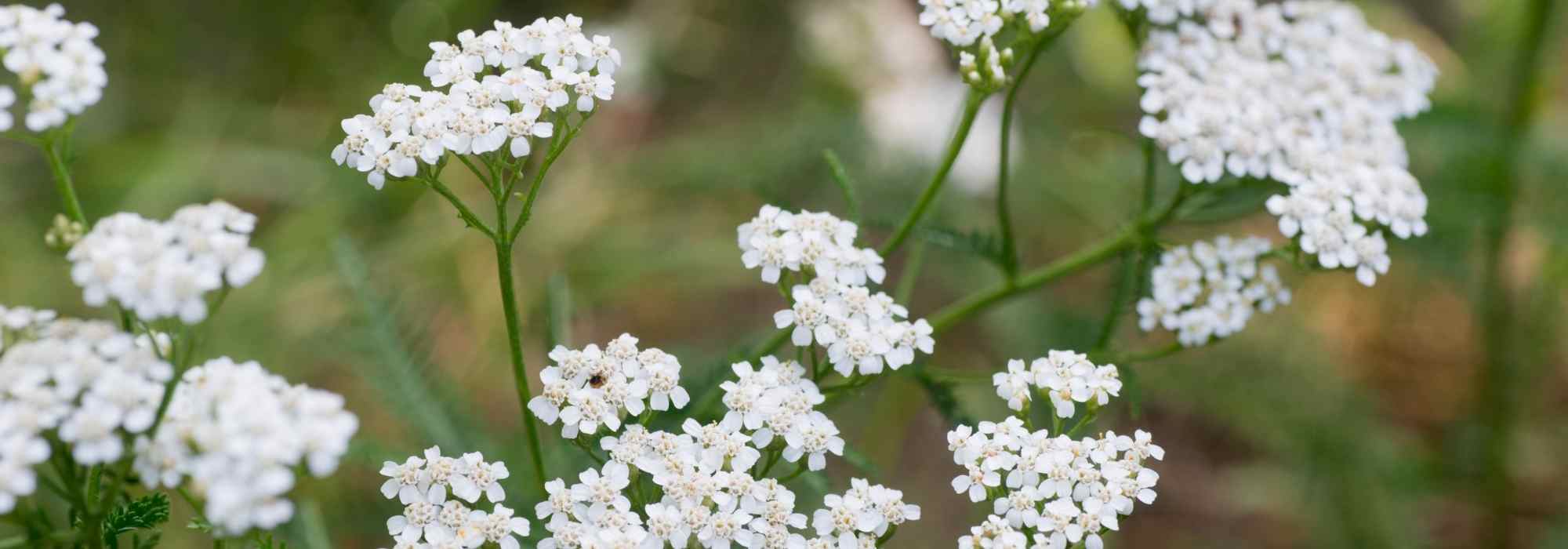
Yarrow: a plant to grow for its medicinal properties
A hardy perennial with multiple health and garden benefits
Contents
Known since antiquity and still valuable today, yarrow (Achillea millefolium) is a hardy herbaceous perennial from the Asteraceae family. Recognised for its melliferous properties, it is highly beneficial to plant in the garden with the aim of maintaining biodiversity. Moreover, it is very hardy, low-maintenance, and undemanding. Yarrow naturally grows in wild meadows, pastures, and along pathways, but it easily finds its place in dry borders, flower beds, and rockeries. But did you know that this plant, with its feathery foliage and long-lasting flowering heads, is also known for its medicinal virtues?
Its prolonged summer flowering, ease of cultivation, and aromatic properties make it a must-have for gardeners interested in phytotherapy. However, to make the most of yarrow, it is essential to understand its botany, multiple uses, and necessary precautions.
To go further: Yarrow, Achillea: planting, cultivating, and maintaining
Presentation of Yarrow
Yarrow is a perennial rhizomatous plant, forming dense clumps 30 to 80 cm high depending on the varieties and growing conditions. Its spreading rootstock gives rise to very leafy, single stems, often woolly. Yarrow is recognised by its finely dissected leaves, a greyish green, which are very aromatic when crushed. Woolly in its youth, then villous and practically glabrous, this foliage is divided into small lanceolate tips, curled at the end. Highly dissected, almost feathery, this foliage inspired its name “millefeuille” (thousand leaves), while the genus name refers to the Greek hero Achilles, who, according to legend, used it to heal the wounds of his soldiers. Hence its name as the herb for soldiers.
But this plant is also known by other vernacular names, all of which carry a particular meaning, generally of a medicinal nature: herb for cuts, carpenter’s herb, nosebleed herb, coachman’s herb, turkey herb, Saint John’s herb…
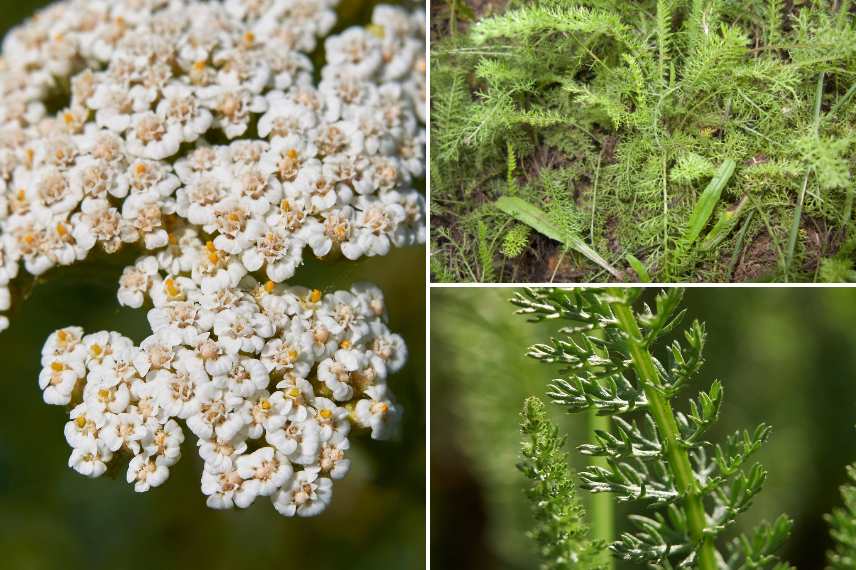 Yarrow is a plant of the Asteraceae family
Yarrow is a plant of the Asteraceae family
Yarrow is also distinguished by its flowering. The stems end in rich corymbose panicles, composed of fine capitula. The flowers are regular and tubular, ranging from dirty white to yellowish, sometimes slightly pinkish, for the type species. However, there is a multitude of horticultural species with very varied flower colours, from pastels to very warm tones. These inflorescences are melliferous and extremely attractive to pollinators, particularly hoverflies, bees, and certain butterflies. Yarrow flowers from June to September, depending on the region and exposure.
Tolerant of drought once established, it prefers well-drained soils and sunny locations, but also adapts to poor or calcareous ground. Its spreading and rhizomatous habit can make it invasive in loose soil, but this vigour is valuable for covering a bank, the base of a tree, or stabilising soil.
How to use yarrow?
The different parts of yarrow, used in phytotherapy, namely the flowering tops, leaves, and stems, contain numerous bioactive compounds:
- The essential oils it contains, including camphor and azulene, are known for their antiseptic, anti-inflammatory, and mildly analgesic properties. Camphor locally stimulates circulation, while azulene, a blue pigment derived from the distillation of certain aromatic molecules, has soothing and restorative virtues on inflamed or damaged tissues.
- Flavonoids, powerful antioxidants, contribute to hormonal regulation, support the vascular system, and help combat oxidative stress.
- Tannins exert an astringent action that tightens tissues and slows minor bleeding, which justifies the traditional use of yarrow on superficial wounds.
- Salicylic acid, a natural precursor of aspirin, gives the plant a mild antipyretic and analgesic action, useful in cases of fever or diffuse pain.
- Sesquiterpene lactones, although present in small quantities, play a significant role in the anti-inflammatory and immunomodulatory effects of the plant, particularly on digestive mucous membranes and menstrual disorders.
In medicinal use, fresh inflorescences, harvested from June to September, or dried in bouquets in the shade, in a well-ventilated area, are used. The leaves are also useful. They are harvested in May and early June, before flowering. Drying is done in the shade, but the leaves can also be used fresh. The stems are also included in the composition of dry or fresh preparations.
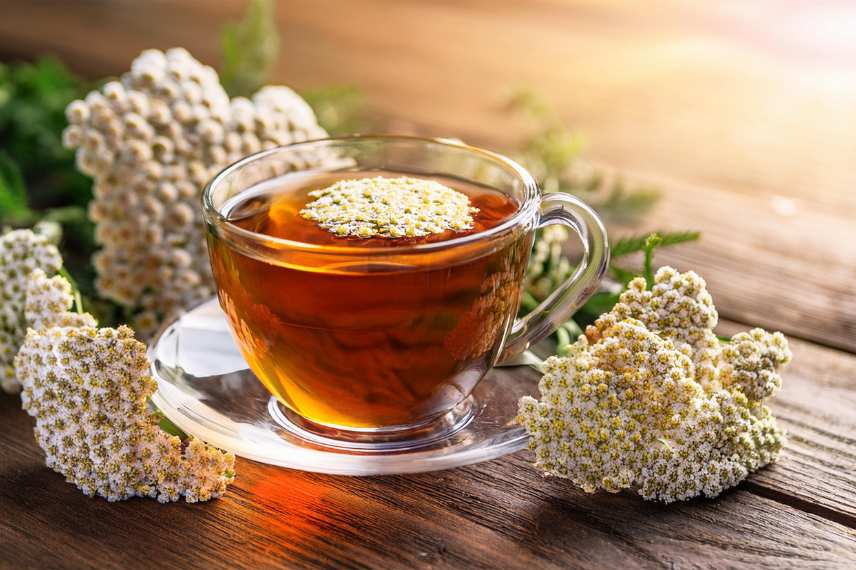 The flowers and leaves of yarrow are prepared as an infusion
The flowers and leaves of yarrow are prepared as an infusion
Yarrow will be used in various forms:
- As an infusion: one to two teaspoons of dried plant (1 to 2 g) per cup of 150 ml of boiling water. Let it steep covered for 10 minutes and strain. Consume 1 to 4 cups per day.
- For external use, in the form of a decoction: bring 10 to 20 g of dried plant per litre of water to a boil, let simmer for 5 minutes, then steep for 10 minutes off the heat. Once cooled, the decoction can be applied as a sterile compress soaked on the affected area for one hour, three times a day.
- In infused oil: Place dried flowering tops in a sterilised jar, covering them completely with a stable vegetable oil (such as olive or calendula oil), and let macerate in the sun for three weeks. The oil is then filtered and stored away from light.
- In an emergency, fresh leaves can be simply crushed to release their juices and applied directly to a small cut or sting.
What are the benefits of yarrow on the body?
Achillea millefolium is renowned for its numerous benefits for well-being and health, thanks to its wide range of therapeutic actions:
Antispasmodic and Digestive
Achillea millefolium calms involuntary contractions of smooth muscles, relieving intestinal spasms, digestive colic, and pain associated with irritable bowel syndrome.
Its cholagogue action stimulates bile production, thus facilitating the digestion of fats and preventing feelings of heaviness after meals. This property is particularly useful during periods of slow digestion or in cases of functional liver disorders.
Regulation of the Menstrual Cycle
Achillea is also known for its regulatory effects on the menstrual cycle. It is classified among the so-called emmenagogues: it promotes a balanced menstrual flow, soothes uterine pain, and supports women in cases of irregular or excessively heavy periods. This gentle regulation, linked to the presence of flavonoids with slightly oestrogenic effects, also helps alleviate certain discomforts of perimenopause, such as hot flashes or cyclical headaches.
Tonic Action on Blood Circulation
It improves venous return, alleviates the sensation of heavy legs, and limits the formation of small superficial varices. Its tannins and lactones also provide haemostatic properties, valuable for mitigating minor haemorrhages (cuts, nosebleeds, excessively heavy periods).
Healing Properties
When used externally, Achillea millefolium promotes the healing of superficial wounds, abrasions, cracks, or insect bites due to a combination of antiseptic, astringent, and anti-inflammatory effects. This ability to soothe mucous membranes and close damaged tissues is well documented and appreciated in field herbalism.
Anti-inflammatory Virtues
Azulene, one of its most active components, possesses powerful anti-inflammatory properties, often compared to those of German chamomile. Its action is particularly interesting in low-grade inflammatory states affecting both the skin, mucous membranes, and certain joint areas. It can thus be incorporated into creams or balms to relieve minor arthritic or tendinous pains, especially when they are of chronic inflammatory origin.
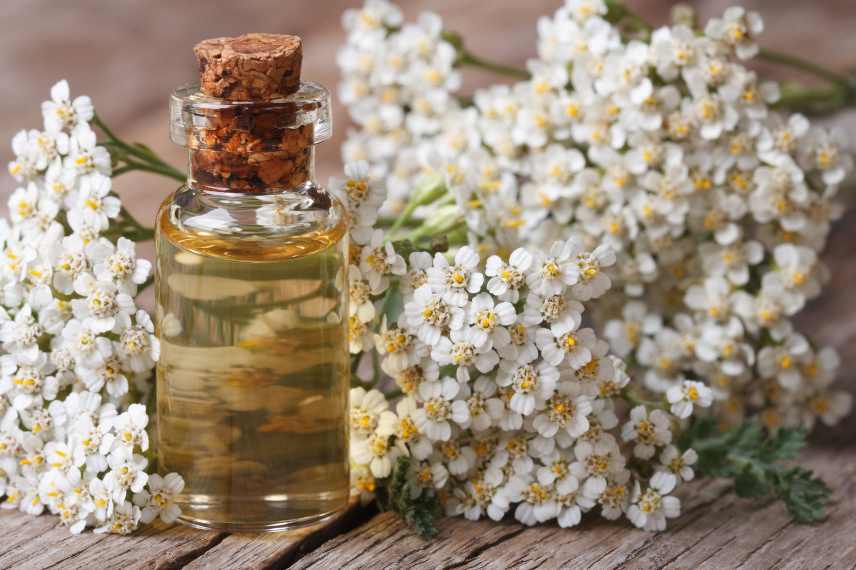
Achillea millefolium in infused oil for wounds and bruises
What are the side effects and contraindications of yarrow?
As with any active plant with proven benefits, yarrow is not without precautions regarding its use. Moreover, it is rich in essential oils and active principles. Therefore, it should be used wisely. It is always advisable to seek informed advice from a specialist or a doctor before consuming yarrow for internal or external use, especially in the case of ongoing treatment.
- Yarrow, being a plant from the Asteraceae family, can potentially cause allergies that manifest as contact dermatitis, skin rashes, or digestive disorders.
- Its use is not recommended for pregnant or breastfeeding women, as some components may have a uterine effect or pass into breast milk.
- It may interact with certain anticoagulant or antihypertensive treatments due to its circulatory properties.
- Subscribe!
- Contents
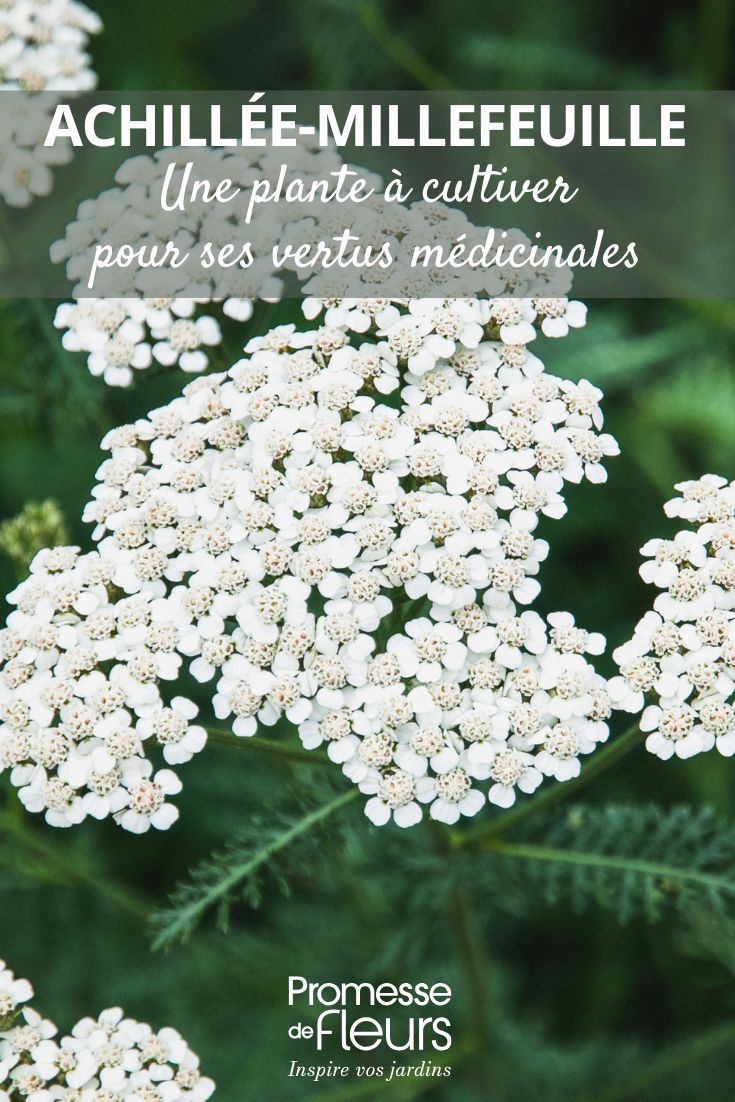































Comments